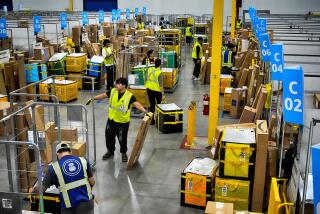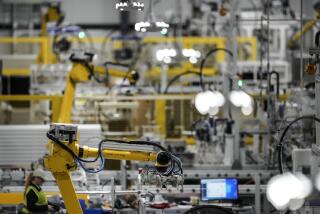Growth in 2nd Quarter ‘Anemic’ : Economy: The 1.6% increase in gross domestic product falls far below expectations, reviving fears about the strength of the recovery.
WASHINGTON — The U.S. economy grew at a faint 1.6% annual rate during the second quarter, the Commerce Department said Thursday in a report that fell far short of expectations and revived fears about the frailty of the recovery.
The April-June growth of the gross domestic product--the sum of all goods and services produced in the United States--was an improvement over the previous quarter’s 0.7% rate but compared poorly with the 4.7% rate recorded in the last three months of 1992.
The second-quarter figure surprised Washington economists and Wall Street analysts, most of whom were expecting growth in the 2% to 3% range. In congressional hearings a week ago, Federal Reserve Board Chairman Alan Greenspan predicted second-quarter growth of 2.5%.
Commerce Secretary Ronald H. Brown called the second-quarter growth rate “anemic” and said that Congress must pass President Clinton’s economic package as “a first step in ensuring the sustained growth and economic health of our country.”
In a prepared statement, House Banking, Finance and Urban Affairs Committee Chairman Henry B. Gonzalez (D-Tex.) lashed out at Greenspan for his overly optimistic growth predictions.
“The Federal Reserve is supposed to be champion number crunchers, but the only thing they seem to be crunching is the economy,” said Gonzalez, who complained that Greenspan is “wholly disconnected from reality” and has kept the money supply “dangerously low.”
The GDP figures were accompanied by the release of additional economic data that contained mixed signals.
The Commerce Department announced a stout $31.6-billion increase in consumer spending in the second quarter, while the Labor Department said that the number of people filing first-time jobless claims last week rose by 43,000 to 394,000, the highest level in 10 months.
While some analysts pointed to a 16.5% increase in the rate of capital equipment purchases as evidence that businesses were enjoying greater profits, others said that many of the computers and machines businesses bought are meant to replace labor.
“Business is spending money to save money,” said Allen Sinai, chief economist for Economic Advisers in New York City.
Private economists said that their optimistic growth-rate forecasts were dashed because businesses added $25.3 billion fewer goods to their inventories than in the first quarter of the year.
Some, however, took the combination of pared inventories and increased consumer spending as an encouraging sign. “By cleaning the shelves of excess goods, now the stage is set for increased output,” said Mike Penzer, senior economist at Bank of America in San Francisco.
Most analysts, sobered by Thursday’s report, now predict a best-case scenario of slow and steady growth for the remainder of the year.
Yet-to-be-approved federal tax increases and spending cuts, intended to reduce the federal deficit by $500 billion over five years, would inhibit growth in the short term by perhaps a percentage point, economists said.
Continued defense and aerospace cutbacks, an oversupply of office space in most cities, consolidation of financial and retail institutions, flooding in the Midwest and the drought in the Southeast are expected to slow, but not cripple, economic expansion.
“We have enough life in the other sectors,” Penzer said. “I don’t see us slipping back into a recession.”
GDP
Gross domestic product measures all goods and services produced in the United States, regardless of ownership. Percent change from previous quarter:
1993 2nd quarter: +1.6%
Source: Commerce Department
More to Read
Inside the business of entertainment
The Wide Shot brings you news, analysis and insights on everything from streaming wars to production — and what it all means for the future.
You may occasionally receive promotional content from the Los Angeles Times.










